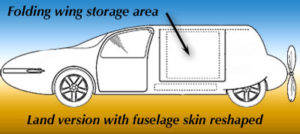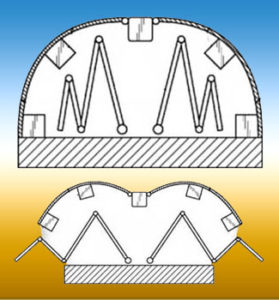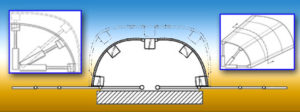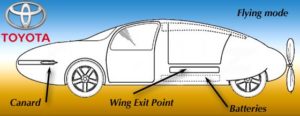Maybe you haven’t heard enough about electric-powered aircraft, flying cars, and automobiles on autopilot (presuming you’re aware of Tesla’s fatal accident in May). How about a shape-shifting aerocar? Huh?! I know it sounds rather crazy but Toyota, being the world’s largest car manufacturer, is not a name to be dismissed when they may choose to delve into the flying car business… twice, in a few months!
Nope, I’m not kidding. The Japanese car company was awarded a patent for a “Shape Morphing Fuselage for an Aerocar.” The illustrations — typical patent artwork — might fool you. This is not some 1930s silliness. The U.S. Patent office published this very recently, on June 23rd, 2016.
Perhaps it’s no more than a publicity generator, much like Amazon’s drone delivery aircraft — about which, by the way, Amazon claims to be sincere. Or, maybe Toyota is afraid Terrafugia might beat them to an interesting market, something like Tesla did to the big boys of auto manufacturing. Maybe they’re just trying to lock up some intellectual property. I wouldn’t know the answer to those questions. I simply found a shape-shifting flying car to be intriguing.

Toyota’s concept allows the wings to be stored within the interior while the car is on land unlike Terrafugia’s Transition.
It is probable Toyota Aerocar inventors and Michigan residents, Umesh Gandhi and Taewoo Nam, know all about Terrafugia and their work on Transition. Toyota could not be seriously worried about a small start up when the multinational company has billions to spend. Nonetheless, they appear to be taking this well beyond Terrafugia’s wing-folding Transition (though not beyond Terrafugia’s much different approach with their Osprey-like, electric-powered TF-X).
Here’s the general description appearing on their patent: “A shape morphing fuselage and method of transitioning an aerocar from a land mode to a flight mode. The fuselage includes… flexible frame member and tensile skin… as well as an actuation system configured to bend the frame members between a contracted configuration associated with flight mode and an expanded configuration association with land mode.” All this is to allow collapsing the folding wings inside the vehicle for road travel. That makes sense but the Aerocar has to store this in space that cannot otherwise be used, rather like a hardtop convertible.
Terrafugia has demonstrated — and publicly flown, at Oshkosh and other locations — their Transition that folds its wings alongside the car body. This method can leave the wings exposed to road rash. Their TF-X design goes far beyond this and does not leave major flight components exposed but that’s another story.
Another online outlet, England’s Daily Mail, wrote, “Toyota believes flying has always been a dream central to the history of humanity and the car manufacturer may be getting closer to making it a reality.” From my read of the patent, I cannot imagine this is particularly serious, but it might be a way to claim patent exclusivity on changeable car body shapes. For an outfit used to making millions of automobiles through several brands, an Aerocar could hardly seem particularly profitable.

When the operator is ready to fly, the wings can be extended generally from the sides of the shape morphing fuselage through a hatch.
Toyota’s “tensile skin” could be constructed with an elastic or stretchy membrane material, like silicone, or a shape-memory material capable of expanding and contracting to smoothly wrap around the car’s frame, according to language contained in the patent application.
So when the operator is ready to fly, the wings can be unfolded and extended — this part is much like Terrafugia’s Transition — from the sides of the fuselage (Mssrs. Gandhi and Nam regularly referred to the Aerocar body as a “fuselage”). However, I see one big difference.
Transition’s wings remain alongside the car where road debris could strike the wings. That always looked vulnerable to many observers. Toyota’s shape-shifting Aerocar brings the wings inside. They can fit because the car body or fuselage can change shapes using actuators inside to twist and tug a tensile, or stretchy, skin. On the road with wings hidden, Aerocar looks something like a minivan. Aloft it becomes more streamlined.
The vehicle “would be driven using a power system that includes a battery pack, internal combustion engine, turbine, fuel cell, or other energy conversion device” driving a propeller or ducted fan. Motive power does not seem to be Toyota’s main concern, partly as illustrated by the kludgy prop at the rear that would also have to be pulled inside… and the patent has no language about that.

The fuselage could employ a tensile body that stretches between flexible frame members that optimizes shape for flight versus ground operation.
Toyota engineers Gandhi and Nam dryly note that a vehicle designed with this futuristic morphing technology “can require physical trade-offs in design in order to facilitate operations in both the land mode and the flight mode,” according to the patent published by the U.S. Patent and Trademark Office. Aerocar isn’t designed with the passenger’s comfort in mind, but is shaped to optimize aerodynamic lift, limit drag, and support flight stability.
So, is Toyota likely to enter the flying car business? Do they have a couple (or more) engineers working on things like Google’s “Moonshot” group does, where the pay-off, if any, is years in the future? Maybe they are merely exploring ideas and filing patents as a way to show they’re actually working on stuff and not wasting their days updating their Facebook pages. Again, I don’t know. Yet when a multinational company with billions of dollars at their ready disposal cracks open the checkbook, it could lead to something interesting.
Toyota’s shape-shifting design isn’t the company’s first flying car proposal. In September 2015, Toyota was awarded another patent for a vehicle that placed the wings under a compartment in the roof that would deploy at the touch of a button.
Maybe this is just an ongoing fascination with a George Jetson flying car that has tantalized humans for years. Then, again, who knows? Could a shape shifting Aerocar be in your future?
Related Articles: Multiple Flying Cars; Itec’s Maverick; China’s CarCopter; Terrafugia’s Weight Increase; AeroMobile 3.0; and, ScaleWings SW91 Aeros



Leave a Reply